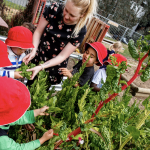Did you ever fantasise about having an extra assistant in your classroom? Would you like someone else to help teach the children, to make clean-up exciting or to explain why maths is fun? You can make this happen by bringing puppets into your classroom.
Puppet play brings a myriad of gains to the classroom, especially in the areas of communication and social skills. Children communicate naturally with puppets and gain confidence in expressing themselves. All children can practise language and vocabulary skills using puppets. For shy children, puppets can be a starting point of expression as they may feel more comfortable expressing themselves through the puppet. It all becomes fun when a puppet is brought into the picture.
Creative skills are augmented by playing with puppets. Children enjoy using different characters and personalities. Let the children choose the roles and names of the puppets; they can create a whole new world and story for the puppet to live in, and broaden their imaginations in the process. By giving children the opportunity to use puppets you allow them to develop their imagination.
Puppets are also easy to create and maintain. A puppet can spring to life using things that are at hand: paper bags, paper cups and plates, plastic bottles, a sock, a pillowcase with a ball tied into one end as a head, sticks with small pictures attached, can all be put to practical use. Much fun can be had through the imaginative use of decorative materials such as stickers, cloth, and other sparkling bits and pieces. Add some markers and you will have a new acquaintance!
The versatility of puppets makes them an object which appeals to all ages. Decide how you will make the best use of puppets in your classroom. You can experiment using the following ideas:
Literacy
- I can vividly recall my teacher introducing letters of the alphabet with a special puppet; it was exciting when our friend arrived to teach us a new letter. Why not see how this works with your class?
- Create characters with interesting voices hidden behind the puppet.
- Use puppets to tell a story and then give children the opportunity to re-enact it by giving them the puppets. You can create a special story-time centre, which can include books, puppets, props, and a homemade stage.
- Practise any script to perform as a puppet play. • Write a story or puppet show to perform.
Maths/Science
- Use glove puppets to illustrate a point about counting and numbers.
- Maths and counting songs are wonderful to teach important skills. A puppet can help out with the singing.
- Finger puppets are great for counting and introducing simple maths skills such as addition and subtraction. For easy finger puppets, cut off the fingertips of old gloves and decorate.
- Create your own bug or animal puppet.
- Use people puppets to learn about body parts and the five senses.
Anytime
- Use puppets to model the social and emotional skills that some children may find challenging.
- Create a facilitator puppet for arguments.
- Introduce a special day, such as a holiday, with a puppet dressed for the occasion.
Puppets really engage and delight children; they add a touch of fun and fantasy and help you go to places you have never been. Explore and experiment using puppets with your students, it will be an adventure for all of you. So what are you waiting for?
This article was originally published in Every Child magazine here.












